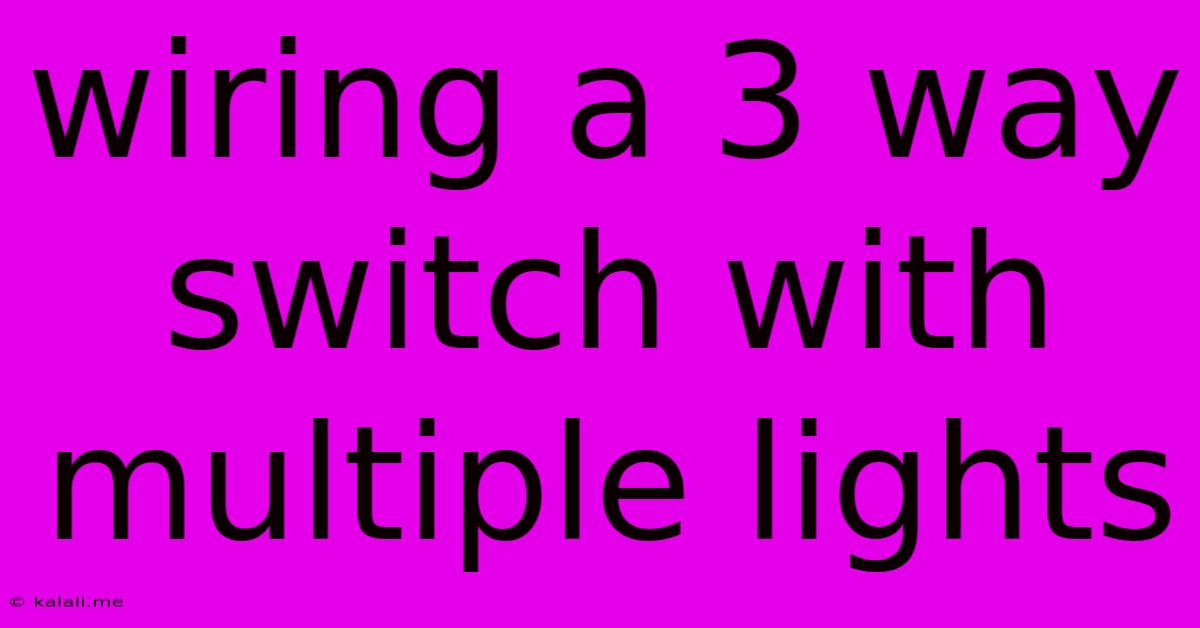Wiring A 3 Way Switch With Multiple Lights
Kalali
Jun 11, 2025 · 4 min read

Table of Contents
Wiring a 3-Way Switch with Multiple Lights: A Comprehensive Guide
This guide provides a step-by-step walkthrough on how to wire a 3-way switch to control multiple lights. This common home wiring project allows you to control the same set of lights from two different locations, offering increased convenience and flexibility. Understanding the basics of electrical wiring, including safety precautions, is crucial before starting this project. If you're uncomfortable working with electricity, consult a qualified electrician.
Understanding 3-Way Switching
Unlike a single-pole switch which controls a light from one location, a 3-way switch setup uses two 3-way switches to control the same light fixture(s) from two different points. This involves using traveler wires that carry the power signal between the two switches. Adding multiple lights simply means each light receives power from the switch circuit.
Materials You'll Need
- Two 3-Way Switches: These switches have three terminals, typically marked as common (COM), traveler 1 (often unmarked or marked as L1), and traveler 2 (often unmarked or marked as L2).
- Electrical Wire: Use wire appropriate for the amperage of your lights. Romex (NM-B) cable is common for residential use. Ensure it's rated for the appropriate voltage.
- Wire Connectors/Wire Nuts: To securely connect wires.
- Electrical Tape: For added insulation.
- Voltage Tester: To ensure power is off before working.
- Screwdriver: Phillips and flathead screwdrivers.
- Wire Strippers: To neatly strip the insulation from the wire ends.
- Junction Box(es): To house the wire connections, especially if not using existing boxes.
Step-by-Step Wiring Instructions
1. Safety First! Turn off the power to the circuit at the breaker box. Use the voltage tester to verify the power is off before touching any wires.
2. Planning Your Wiring: Determine the location of your junction boxes. One will be located between the two 3-way switches, and potentially another at the light fixture(s) themselves, depending on the existing wiring configuration.
3. Wiring the Switches: Here's how to wire each switch:
- Switch 1: Connect the "hot" (black) wire from the power source to the common terminal (COM) of Switch 1. Connect the two traveler wires (usually red and black) to the remaining terminals (L1 and L2) of Switch 1. The order of the traveler wires doesn't matter at this stage.
- Switch 2: Connect the common terminal (COM) of Switch 2 to the wires leading to the light fixture(s). Connect the two traveler wires (red and black) to the remaining terminals (L1 and L2) of Switch 2, ensuring they connect to the same corresponding terminals as on Switch 1 (i.e., the red traveler wire from Switch 1 connects to the red traveler wire from Switch 2).
4. Wiring the Lights:
- Single Light Fixture: Connect the black wire from the switch to the black wire of the light fixture. Connect the white wires together (neutral) and ground wires together (ground).
- Multiple Light Fixtures: Connect the black wires from Switch 2 to the black wires of each light fixture. Ensure all the white (neutral) wires and ground wires are connected together respectively.
5. Secure Connections: Use wire connectors to securely join all the wire ends. Ensure all connections are tight and well-insulated with electrical tape.
6. Mounting the Switches and Light Fixtures: Mount the switches in their respective boxes and securely attach the light fixture(s).
7. Restore Power: Turn the power back on at the breaker box and test the switches. The lights should turn on and off from both switch locations.
Troubleshooting
- Lights don't work: Check all wire connections for tightness and proper insulation. Re-verify the power at the breaker box. Ensure the switches are correctly wired and that the traveler wires are connected consistently.
- Only one switch controls the lights: Double-check the traveler wire connections on both switches. They must be connected identically on both switches.
Adding More Lights
Adding more lights to an existing 3-way circuit usually just involves adding more light fixtures to the existing hot wire run from the second 3-way switch. Make sure your circuit breaker can handle the increased load from additional light fixtures.
This guide provides a general overview. Always consult local electrical codes and seek professional help if you are unsure about any aspect of this project. Remember, safety is paramount when working with electricity.
Latest Posts
Latest Posts
-
What Is The Biggest Ecosystem On Earth
Jun 12, 2025
-
Isotopes Are Atoms That Have
Jun 12, 2025
-
How To Calculate Modulus Of Resilience
Jun 12, 2025
-
This Body Of Water Divides Europe And North Africa
Jun 12, 2025
-
New York University Average Sat Score
Jun 12, 2025
Related Post
Thank you for visiting our website which covers about Wiring A 3 Way Switch With Multiple Lights . We hope the information provided has been useful to you. Feel free to contact us if you have any questions or need further assistance. See you next time and don't miss to bookmark.